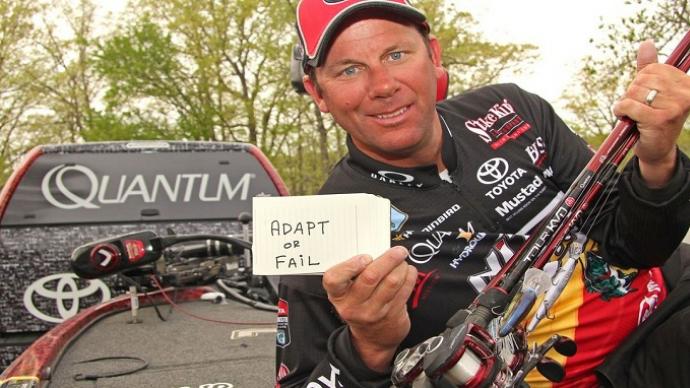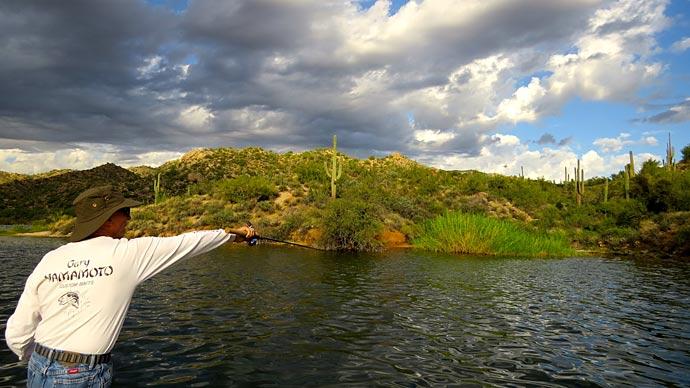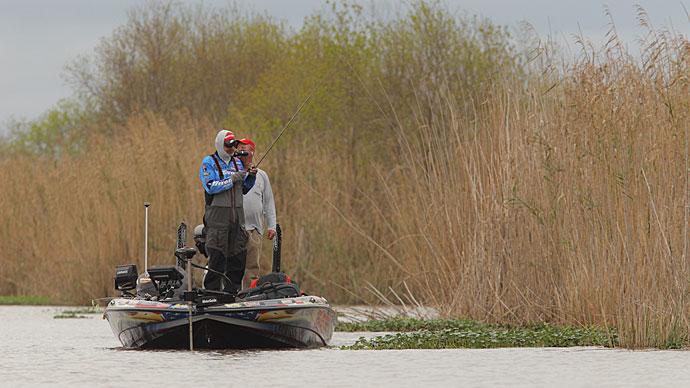
Nothing is more upsetting than having significant changes in conditions the day after pre-fish. A cold front moves through, or the lake drops, and suddenly the fish you found are long gone. The panic mode can set in, but if you stay calm and know a bit about how bass behave, odds are you can re-group, find those fish, and save the day.
We went fishing with Lawrence Dwonch, an up-and-coming tournament bass angler in Arizona, and the poor guy got hit with a double whammy – falling water PLUS a cold front, with a couple of outdoor writers in the boat to boot. I’ve got to hand it to him, though, after blanking in his first three good spots, Dwonch called a time out and began to think things through.
The lake had dropped 30 feet in a week, and the water temperature had dropped from 67 degrees to 61.9. His jerkbait fish were no longer biting, and he wasn’t seeing anything on the graph either. He headed for a big cove on the main lake with steep sides and several good points and began throwing a drop shot on a rock pile in ten feet of water. He had three fish in the boat in ten minutes, but they weren’t the size he was looking for. So, he picked up a deep-diving crankbait and started moving down the bank, steadily retrieving the lure and switching between a lipless bait and a jerk bait. “We’re just trying to locate them now,” he told us, “they are just moving around chasing bait fish.”
He got a reaction bite going on steeper, rocky banks with the jerk bait, and he started seeing fish in five to fifteen feet of water. We moved into a large main-lake cove 40 feet deep with steep sides. The cove was behind a little arm that stuck out and cut the back part off from the main lake. The falling water was bad enough, but the cold front had shut them down, and even the fish he could see were not all that anxious to take a bait. In situations like this, you have two choices: stick with a reaction bait and cover water, switch to a jig or drop shot or something, and try for the sluggish fish. Each has its pros and cons.
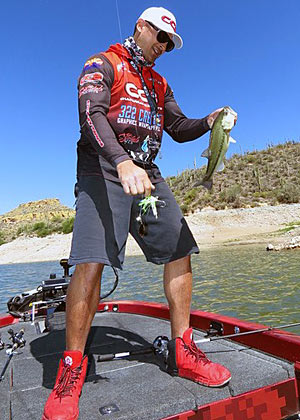
If you stick with a reaction bait, especially in falling water, it helps to move out of the coves. If the water is falling fast, the bass will hightail it out to deeper stuff in a hurry. Points outside coves are good, and so are vertical structures like pilings and rock piles where the bass can suspend. Steep bluffs and steep rocky banks are also good. You don’t have to change baits; change places you fish them. They’ll be moving out to the nearest deep spot like they’re going down the drain.
If it is summer or fall, you’ll already be fishing for deeper fish, so a Carolina rig, a dart head, or a shaky head will work too. Worms and jigs are also a good bet. Find out what the craws and baitfish are doing. Bouncing a jig or dart head down a steep bank or bluff can pay off big time, plus you can still cover water. If you locate a concentration of fish, you can stay and try to get them to bite on a jig or worm. Use light weight and plenty of scents, and give them time to get interested. How long you spend on a bass is up to you – it’s almost like bed fishing in that you can invest a ton of time on one fish. You’ve got to decide how to use the time you have wisely.
Dwonch chose to hit steep stuff with reaction baits. It was a good choice. He headed for some cliffs and began to pick them apart. When you’re faced with a vast expanse of steep banks or a long bluff, you need to figure out exactly which areas of that cliff or bluff are holding fish. In this case, there were places where parts of the cliff had fallen, so now and then, there were rocky areas. Those were the areas that had the most fish on them. Dwonch used the same tactic I’ve seen guys use on those vast expanses of tules at Havasu. It would take hours to fish every dang yard of it, so look for the dark spots that mean deeper water. He looked for the rocky bits on these cliffs and passed over the smooth areas.
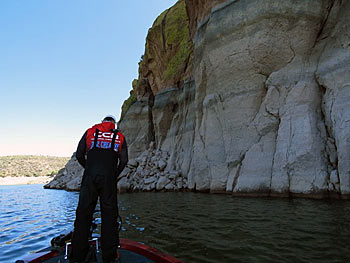
“Practicing is extremely important,” says Dwonch, “things change from month to month and even week to week and day to day, but fish do the same things every year.” Learn the seasonal patterns, and you’ll know where to start, even on a new lake. Then take into account the weather and the water level changes, and you can fine-tune your approach. The key is to stay confident, even if it's tournament day and all your fish are gone. Oddly, you can find them again if you move out and slow down.
_________________________________________
Stay or go? If you are fishing alone, you can do whatever you want. Blow the whole day on one fish if you like. But, if you have a non-boater along with you, especially in a pro-am tournament, you need to consider that other guy. I’ve been a non-boater more times than I can count, and I can tell you that nothing is worse than being behind a guy sitting on a bed of fish for hours. There is nothing you can do but wait. I’ve had some guys who didn’t want me to fish deep off the back of the boat for fear I would spook their fish. The same goes for fishing a concentration of deep fish – unless you’re willing to let the non-boater come up and stand next to you and fish for those same fish, you’re not being fair. Yes, you paid more than he did, but he didn’t pay to watch your fish. Be a sport.


